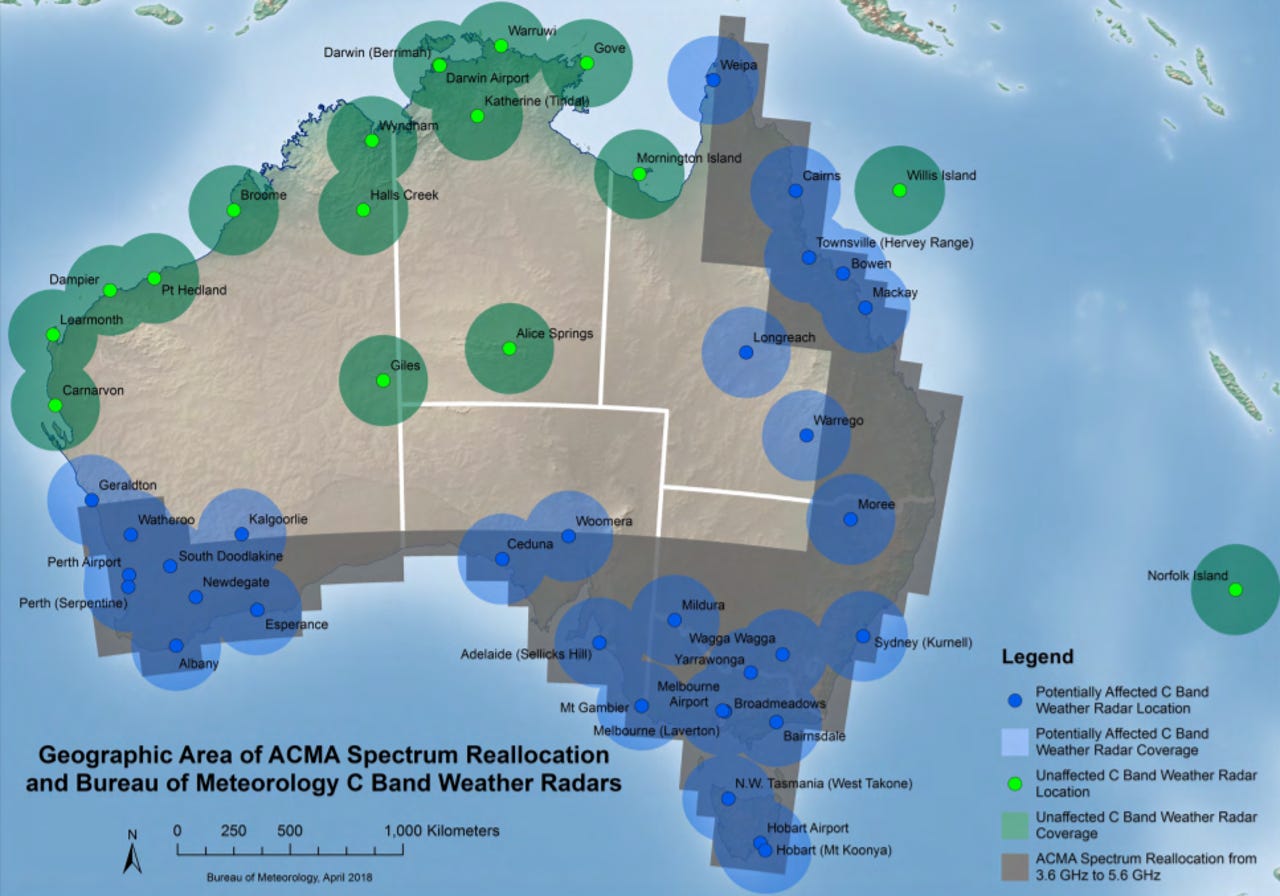5G spectrum changes could impact weather radars


Moving wireless providers to the 5.6GHz band thanks to the upcoming 5G spectrum auction on the 3.6GHz band could impact weather satellites across most of the nation, the Bureau of Meteorology (BoM) has said.
"The Bureau of Meteorology is concerned the reallocation of Wireless Internet Service Providers (WISPs) to the 5.6GHz band could interfere with existing radars and constrain future expansion and reconfiguration of its radar network," the BoM said in response to Senate Estimates Questions on Notice.
The 5.6GHz spectrum is currently used for BOM's 47 C-Band weather radars.
Potentially affected C-Band weather radar locations shown on BOM's map include Sydney (Kurnell), Melbourne Airport, Melbourne (Laverton), Adelaide (Sellicks Hill), Perth Airport, Perth (Serpentine), Hobart Airport, Hobart (Mt Koonya), Cairns, Townsville (Hervey Range), Wagga Wagga, Kalgoorlie, Mildura, Geraldton, NW Tasmania (West Takone), Yarrawonga, Broadmeadows, Mt Gambier, Moree, Woomera, Ceduna, Bairnsdale, Warrego, Longreach, Mackay, Bowen, Weipa, Albany, Esperance, Newdegate, South Doodlakine, and Watheroo.
Unaffected C-band weather radars are limited to Darwin (Berrimah), Darwin Airport, Alice Springs, Broome, Norfolk Island, Katherine (Tindal), Port Hedland, Mornington Island, Willis Island, Warruwi, Wyndham, Halls Creek, Dampier, Learmonth, Carnarvon, and Giles.
According to the BoM, the Australian Communications and Media Authority (ACMA) had consulted BOM directly, via email, and via its public consultation process on the spectrum reallocation before reaching the decision to shift WISPs and satellite providers over to make way for mobile broadband.
The ACMA had released its five-year plan for spectrum allocation in October alongside "a range of mitigation measures" for incumbent users in the 3.6GHz band, including "a commitment to developing arrangements for site-based wireless broadband services in the 5.6GHz" band, support for ongoing access to spectrum, and identifying earth station protection zones on Australia's east coast.
This followed arguments from incumbent wireless ISPs and satellite groups that the spectrum should not be taken away from them and given to mobile telcos.
In March, Communications Minister Mitch Fifield then announced that current services in the 3.6GHz band will have up to seven years to vacate in regional areas, and only two years in most capital cities
"I have carefully considered the implications for regional Australians in making this decision, and the declaration provides protections for incumbent users in the band while ensuring Australia is well-positioned to take advantage of 5G technology in years to come," Fifield said at the time.
"The ACMA's recommendation provides for an unprecedented seven-year reallocation period in regional Australia. This will allow incumbents, such as regional fixed-wireless broadband operators, to continue to deliver services until the middle of next decade -- and this could continue beyond the reallocation period if agreed with a new spectrum licence holder."
This followed the release of the federal government's 5G policy paper, which said the ACMA would bring the 3.6GHz spectrum band for 5G use to auction in 2018.
Related Coverage
- ACMA announces 5G spectrum plan
- South Korea's 5G spectrum auction to start at $3 billion
- Telcos pay £1.4bn for 5G spectrum in the UK
- NBN looks to buy 5G spectrum: Morrow
- Mobile device computing policy (Tech Pro Research)
- FCC approves Samsung 5G portfolio, which could be good news for telecommuters and SMBs (TechRepublic)
- 5G will power digital transformation (TechRepublic)